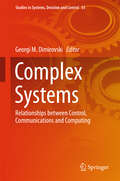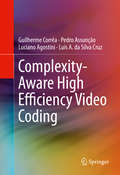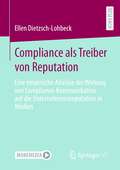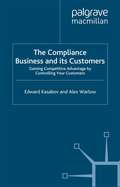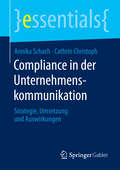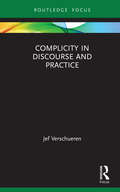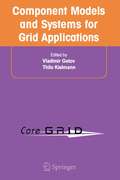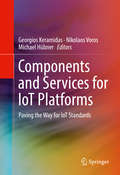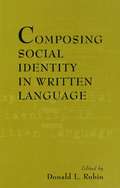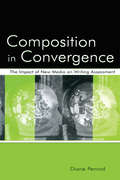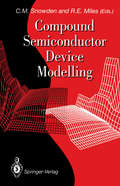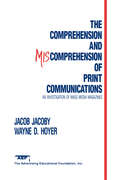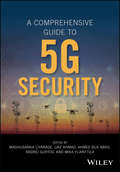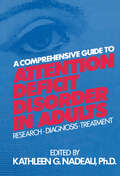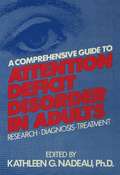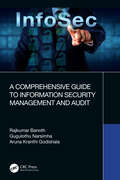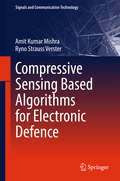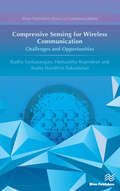- Table View
- List View
Complex Systems: Relationships between Control, Communications and Computing (Studies in Systems, Decision and Control #55)
by Georgi M. DimirovskiThis book gives a wide-ranging description of the many facets of complex dynamic networks and systems within an infrastructure provided by integrated control and supervision: envisioning, design, experimental exploration, and implementation. The theoretical contributions and the case studies presented can reach control goals beyond those of stabilization and output regulation or even of adaptive control. Reporting on work of the Control of Complex Systems (COSY) research program, Complex Systems follows from and expands upon an earlier collection: Control of Complex Systems by introducing novel theoretical techniques for hard-to-control networks and systems. The major common feature of all the superficially diverse contributions encompassed by this book is that of spotting and exploiting possible areas of mutual reinforcement between control, computing and communications. These help readers to achieve not only robust stable plant system operation but also properties such as collective adaptivity, integrity and survivability at the same time retaining desired performance quality.Applications in the individual chapters are drawn from:• the general implementation of model-based diagnosis and systems engineering in medical technology, in communication, and in power and airport networks;• the creation of biologically inspired control brains and safety-critical human–machine systems,• process-industrial uses;• biped robots; • large space structures and unmanned aerial vehicles; and• precision servomechanisms and other advanced technologies.Complex Systems provides researchers from engineering, applied mathematics and computer science backgrounds with innovative theoretical and practical insights into the state-of-the-art of complex networks and systems research. It employs physical implementations and extensive computer simulations. Graduate students specializing in complex-systems
Complexity-Aware High Efficiency Video Coding
by Guilherme Corrêa Pedro Assunção Luciano Agostini Luis A. CruzThis book discusses computational complexity of High Efficiency Video Coding (HEVC) encoders with coverage extending from the analysis of HEVC compression efficiency and computational complexity to the reduction and scaling of its encoding complexity. After an introduction to the topic and a review of the state-of-the-art research in the field, the authors provide a detailed analysis of the HEVC encoding tools compression efficiency and computational complexity. Readers will benefit from a set of algorithms for scaling the computational complexity of HEVC encoders, all of which take advantage from the flexibility of the frame partitioning structures allowed by the standard. The authors also provide a set of early termination methods based on data mining and machine learning techniques, which are able to reduce the computational complexity required to find the best frame partitioning structures. The applicability of the proposed methods is finally exemplified with an encoding time control system that employs the best complexity reduction and scaling methods presented throughout the book. The methods presented in this book are especially useful in power-constrained, portable multimedia devices to reduce energy consumption and to extend battery life. They can also be applied to portable and non-portable multimedia devices operating in real time with limited computational resources.
Compliance als Treiber von Reputation: Eine empirische Analyse der Wirkung von Compliance-Kommunikation auf die Unternehmensreputation in Medien
by Ellen Dietzsch-LohbeckCompliance hat nach großen Wirtschaftsskandalen, wie Korruption bei Siemens und dem Abgasskandal in der deutschen Automobilindustrie, Einzug in fast jedes Unternehmen gehalten. Der Wert von Compliance wird häufig nicht nur darin gesehen, vor Rechtsverstößen und Fehlverhalten zu schützen, sondern auch den guten Ruf zu fördern. Das Buch beleuchtet die Frage, ob es sich für Unternehmen im Hinblick auf ihre Reputation in den Medien lohnt, Compliance als Thema in der Unternehmenskommunikation zu verankern. Anhand einer Fallstudie mit drei Automobilherstellern untersucht Ellen Dietzsch-Lohbeck die externe Kommunikation der Unternehmen zu Compliance. Ferner geht sie der Frage nach, ob die Compliance-Kommunikation der Unternehmen einen Einfluss auf die Wirtschaftsberichterstattung und auf die Medienreputation in drei überregionalen Tageszeitungen in Deutschland ausübt. Damit hat Ellen Dietzsch-Lohbeck erstmals das Thema Compliance in der externen Unternehmenskommunikation umfassend untersucht. Sie hat auch analysiert, wie Zeitungen das Thema Compliance bei Unternehmen darstellen und welche Medienreputation sie dabei vermitteln.
The Compliance Business and Its Customers: Gaining Competitive Advantage by Controlling Your Customers
by E. Kasabov A. WarlowThe internet has changed the way consumers interact with companies. Businesses must maintain good levels of customer service in a digital world where old strategies may no longer suffice. This book explores what the successful compliance-centred businesses are doing to manage and improve customer experience.
Compliance in der Unternehmenskommunikation: Strategie, Umsetzung und Auswirkungen (essentials)
by Annika Schach Cathrin ChristophDas Essential bietet eine umfassende Einführung in die Kommunikation von Compliance aus konzeptioneller, redaktioneller und rechtlicher Perspektive. Annika Schach und Cathrin Christoph beschreiben die Maßnahmen der internen und externen Kommunikation, die notwendig sind, um alle relevanten Stakeholder zu erreichen. Darüber hinaus schildern sie die Besonderheiten bei der Verschriftlichung von Verhaltensregeln in Form eines Code of Conduct und gehen auf den Einfluss von Compliance auf die Medien- und PR-Arbeit ein – inklusive Einblick in die Praxis in Form eines Interviews mit einem der Redakteure von Europas größtem Automobilmagazin.
Complicity in Discourse and Practice (Routledge Focus on Applied Linguistics)
by Jef VerschuerenIt is commonplace to say that we are living in troubled times. Liberal democracy is in crisis. Academic freedom is seriously constrained. The media offers less insight and analysis than could be expected given the proliferation of communication tools. Based on decades of research into the social and ideological functioning of discourse and with a focus on politics, universities, and the media, Jef Verschueren offers an analysis of current practices, asks whether we are all complicit, and makes suggestions for what we can do. Central to this book is the notion of derailed reflexivity, referring to the observation that politics, institutions, and news reporting tend to be excessively aimed at public opinion, impression management, and clicks, to the detriment of policies addressing social justice issues, high-quality service, and media content. Highlighting that education is the cornerstone for democratic choices and ensures that we can critically assess media content, this book shows that shared responsibility can be a source of hope and that everyone has the power to intervene. Complicity in Discourse and Practice is a call to action for readers and a plea for actively minding the ecology of the public sphere.
Complicity in Discourse and Practice (Routledge Focus on Applied Linguistics)
by Jef VerschuerenIt is commonplace to say that we are living in troubled times. Liberal democracy is in crisis. Academic freedom is seriously constrained. The media offers less insight and analysis than could be expected given the proliferation of communication tools. Based on decades of research into the social and ideological functioning of discourse and with a focus on politics, universities, and the media, Jef Verschueren offers an analysis of current practices, asks whether we are all complicit, and makes suggestions for what we can do. Central to this book is the notion of derailed reflexivity, referring to the observation that politics, institutions, and news reporting tend to be excessively aimed at public opinion, impression management, and clicks, to the detriment of policies addressing social justice issues, high-quality service, and media content. Highlighting that education is the cornerstone for democratic choices and ensures that we can critically assess media content, this book shows that shared responsibility can be a source of hope and that everyone has the power to intervene. Complicity in Discourse and Practice is a call to action for readers and a plea for actively minding the ecology of the public sphere.
Component Models and Systems for Grid Applications: Proceedings of the Workshop on Component Models and Systems for Grid Applications held June 26, 2004 in Saint Malo, France.
by Vladimir Getov Thilo KielmannComponent Models and Systems for Grid Applications is the essential reference for the most current research on Grid technologies. This first volume of the CoreGRID series addresses such vital issues as the architecture of the Grid, the way software will influence the development of the Grid, and the practical applications of Grid technologies for individuals and businesses alike. Part I of the book, "Application-Oriented Designs", focuses on development methodology and how it may contribute to a more component-based use of the Grid. "Middleware Architecture", the second part, examines portable Grid engines, hierarchical infrastructures, interoperability, as well as workflow modeling environments. The final part of the book, "Communication Frameworks", looks at dynamic self-adaptation, collective operations, and higher-order components. With Component Models and Systems for Grid Applications, editors Vladimir Getov and Thilo Kielmann offer the computing professional and the computing researcher the most informative, up-to-date, and forward-looking thoughts on the fast-growing field of Grid studies.
Components and Services for IoT Platforms: Paving the Way for IoT Standards
by Georgios Keramidas Nikolaos Voros Michael HübnerThis book serves as a single-source reference to the state-of-the-art in Internet of Things (IoT) platforms, services, tools, programming languages, and applications. In particular, the authors focus on IoT-related requirements such as low-power, time-to-market, connectivity, reliability, interoperability, security, and privacy. Authors discuss the question of whether we need new IoT standardization bodies or initiatives, toward a fully connected, cyber-physical world. Coverage includes the research outcomes of several, current European projects related to IoT platforms, services, APIs, tools, and applications.
Compose Yourself: and write good English (Penguin Reference Bks.)
by Harry BlamiresThis book has a simple thesis: to write well you need to think clearly about what you want to say.Blamires brings the reader's common sense into play to illustrate how by thinking through what you want to say and how you say it, you can communicate both effectively and elegantly. There are a lot of contemporary examples from magazines, books, advertising material and the like to illustrate both good and bad English.
Composing Social Identity in Written Language
by Donald L. RubinThis volume constitutes a unique contribution to the literature on literacy and culture in several respects. It links together aspects of social variation that have not often been thus juxtaposed: ethnicity/nationality, gender, and participant role relations. The unifying theme of this collection of papers is that all of these factors are aspects of writers' identities -- identities which are simultaneously expressed and constructed in text. The topic of social identity and writing can be approached from a variety of scholarly avenues, including humanistic, critical, and historical perspectives. The papers in the present volume make reference to and contribute to such humanistic perspectives; however, this book lies squarely within the tradition of social science. It draws primarily upon the disciplines of linguistics, discourse analysis, anthropology, social and cognitive psychology, and education studies. The constituent topics of social identity, style, and writing themselves lie at the intersections of several related fields of scholarship. Writing remains of peak interest to educators from many fields, and is still a "hot" topic. The instructional ramifications of the particular issues addressed in this volume are of vital concern to educational systems adjusting to the realities of our multicultural society. This publication, therefore, should attract a substantial and diverse readership of scholars, educators, and policymakers affiliated with many fields including applied linguistics, composition and rhetoric, communication studies, dialect studies, discourse analysis, English composition, English/language arts education, ethnic studies, language behavior, literacy, sociolinguistics, stylistics, women's studies, and writing research and instruction.
Composing Social Identity in Written Language
by Donald L. RubinThis volume constitutes a unique contribution to the literature on literacy and culture in several respects. It links together aspects of social variation that have not often been thus juxtaposed: ethnicity/nationality, gender, and participant role relations. The unifying theme of this collection of papers is that all of these factors are aspects of writers' identities -- identities which are simultaneously expressed and constructed in text. The topic of social identity and writing can be approached from a variety of scholarly avenues, including humanistic, critical, and historical perspectives. The papers in the present volume make reference to and contribute to such humanistic perspectives; however, this book lies squarely within the tradition of social science. It draws primarily upon the disciplines of linguistics, discourse analysis, anthropology, social and cognitive psychology, and education studies. The constituent topics of social identity, style, and writing themselves lie at the intersections of several related fields of scholarship. Writing remains of peak interest to educators from many fields, and is still a "hot" topic. The instructional ramifications of the particular issues addressed in this volume are of vital concern to educational systems adjusting to the realities of our multicultural society. This publication, therefore, should attract a substantial and diverse readership of scholars, educators, and policymakers affiliated with many fields including applied linguistics, composition and rhetoric, communication studies, dialect studies, discourse analysis, English composition, English/language arts education, ethnic studies, language behavior, literacy, sociolinguistics, stylistics, women's studies, and writing research and instruction.
Composition in Convergence: The Impact of New Media on Writing Assessment
by Diane PenrodComposition in Convergence: The Impact of New Media on Writing Assessment considers how technological forms--such as computers and online courses--transform the assessment of writing, in addition to text classroom activity. Much has been written on how technology has affected writing, but assessment has had little attention. In this book, author Diane Penrod examines how, on the one hand, computer technology and interactive material create a disruption of conventional literacy practices (reading, writing, interpreting, and critique), while, on the other hand, the influence of computers allows teachers to propose and develop new models for thinking and writing to engage students in real-world settings.This text is intended for scholars and educators in writing and composition, educational assessment, writing and technology, computers and composition, and electronic literacy. In addition, it is appropriate for graduate students planning to teach and assess electronic writing or teach in online environments.
Composition in Convergence: The Impact of New Media on Writing Assessment
by Diane PenrodComposition in Convergence: The Impact of New Media on Writing Assessment considers how technological forms--such as computers and online courses--transform the assessment of writing, in addition to text classroom activity. Much has been written on how technology has affected writing, but assessment has had little attention. In this book, author Diane Penrod examines how, on the one hand, computer technology and interactive material create a disruption of conventional literacy practices (reading, writing, interpreting, and critique), while, on the other hand, the influence of computers allows teachers to propose and develop new models for thinking and writing to engage students in real-world settings.This text is intended for scholars and educators in writing and composition, educational assessment, writing and technology, computers and composition, and electronic literacy. In addition, it is appropriate for graduate students planning to teach and assess electronic writing or teach in online environments.
Compound Semiconductor Device Modelling
by Christopher M. Snowden Robert E. MilesCompound semiconductor devices form the foundation of solid-state microwave and optoelectronic technologies used in many modern communication systems. In common with their low frequency counterparts, these devices are often represented using equivalent circuit models, but it is often necessary to resort to physical models in order to gain insight into the detailed operation of compound semiconductor devices. Many of the earliest physical models were indeed developed to understand the 'unusual' phenomena which occur at high frequencies. Such was the case with the Gunn and IMPATI diodes, which led to an increased interest in using numerical simulation methods. Contemporary devices often have feature sizes so small that they no longer operate within the familiar traditional framework, and hot electron or even quantum mechanical models are required. The need for accurate and efficient models suitable for computer aided design has increased with the demand for a wider range of integrated devices for operation at microwave, millimetre and optical frequencies. The apparent complexity of equivalent circuit and physics-based models distinguishes high frequency devices from their low frequency counterparts . . Over the past twenty years a wide range of modelling techniques have emerged suitable for describing the operation of compound semiconductor devices. This book brings together for the first time the most popular techniques in everyday use by engineers and scientists. The book specifically addresses the requirements and techniques suitable for modelling GaAs, InP. ternary and quaternary semiconductor devices found in modern technology.
The Comprehension and Miscomprehension of Print Communication
by Jacob Jacoby Wayne D. HoyerFirst Published in 1987. Routledge is an imprint of Taylor & Francis, an informa company.
The Comprehension and Miscomprehension of Print Communication
by Jacob Jacoby Wayne D. HoyerFirst Published in 1987. Routledge is an imprint of Taylor & Francis, an informa company.
A Comprehensive Guide to 5G Security
by Madhusanka Liyanage Ijaz Ahmad Ahmed Bux Abro Andrei Gurtov Mika YlianttilaThe first comprehensive guide to the design and implementation of security in 5G wireless networks and devices Security models for 3G and 4G networks based on Universal SIM cards worked very well. But they are not fully applicable to the unique security requirements of 5G networks. 5G will face additional challenges due to increased user privacy concerns, new trust and service models and requirements to support IoT and mission-critical applications. While multiple books already exist on 5G, this is the first to focus exclusively on security for the emerging 5G ecosystem. 5G networks are not only expected to be faster, but provide a backbone for many new services, such as IoT and the Industrial Internet. Those services will provide connectivity for everything from autonomous cars and UAVs to remote health monitoring through body-attached sensors, smart logistics through item tracking to remote diagnostics and preventive maintenance of equipment. Most services will be integrated with Cloud computing and novel concepts, such as mobile edge computing, which will require smooth and transparent communications between user devices, data centers and operator networks. Featuring contributions from an international team of experts at the forefront of 5G system design and security, this book: Provides priceless insights into the current and future threats to mobile networks and mechanisms to protect it Covers critical lifecycle functions and stages of 5G security and how to build an effective security architecture for 5G based mobile networks Addresses mobile network security based on network-centricity, device-centricity, information-centricity and people-centricity views Explores security considerations for all relative stakeholders of mobile networks, including mobile network operators, mobile network virtual operators, mobile users, wireless users, Internet-of things, and cybersecurity experts Providing a comprehensive guide to state-of-the-art in 5G security theory and practice, A Comprehensive Guide to 5G Security is an important working resource for researchers, engineers and business professionals working on 5G development and deployment.
A Comprehensive Guide to 5G Security
by Madhusanka Liyanage Ijaz Ahmad Ahmed Bux Abro Andrei Gurtov Mika YlianttilaThe first comprehensive guide to the design and implementation of security in 5G wireless networks and devices Security models for 3G and 4G networks based on Universal SIM cards worked very well. But they are not fully applicable to the unique security requirements of 5G networks. 5G will face additional challenges due to increased user privacy concerns, new trust and service models and requirements to support IoT and mission-critical applications. While multiple books already exist on 5G, this is the first to focus exclusively on security for the emerging 5G ecosystem. 5G networks are not only expected to be faster, but provide a backbone for many new services, such as IoT and the Industrial Internet. Those services will provide connectivity for everything from autonomous cars and UAVs to remote health monitoring through body-attached sensors, smart logistics through item tracking to remote diagnostics and preventive maintenance of equipment. Most services will be integrated with Cloud computing and novel concepts, such as mobile edge computing, which will require smooth and transparent communications between user devices, data centers and operator networks. Featuring contributions from an international team of experts at the forefront of 5G system design and security, this book: Provides priceless insights into the current and future threats to mobile networks and mechanisms to protect it Covers critical lifecycle functions and stages of 5G security and how to build an effective security architecture for 5G based mobile networks Addresses mobile network security based on network-centricity, device-centricity, information-centricity and people-centricity views Explores security considerations for all relative stakeholders of mobile networks, including mobile network operators, mobile network virtual operators, mobile users, wireless users, Internet-of things, and cybersecurity experts Providing a comprehensive guide to state-of-the-art in 5G security theory and practice, A Comprehensive Guide to 5G Security is an important working resource for researchers, engineers and business professionals working on 5G development and deployment.
A Comprehensive Guide To Attention Deficit Disorder In Adults: Research, Diagnosis and Treatment
by Kathleen G. NadeauThis groundbreaking volume, written by pioneering clinicians and researchers firmly convinced of the neurobiological underpinnings of ADD in adults, is the first to provide broad coverage of this burgeoning field. Written for professionals who diagnose and treat adults with ADD, it provides information from psychologists and physicians on the most current research and treatment issues regarding our understanding of ADD as a neurobiological disorder. According to the contributors, ADD in adults may be responsible for difficulties ranging from minor attention, memory, and organization problems in well-functioning adults to drug abuse and criminal behavior. A Comprehensive Guide to Attention Deficit Disorder in Adults begins by addressing the history of ADD and the evolution of our understanding of the disorder. The neurobiology of ADD is examined, laying a solid foundation for the clinician to develop a scientific understanding of this complex syndrome. The assessment and differential diagnosis of ADD is explored from the perspectives of a variety of specialists in the field. This includes an exploration of the interrelationships between attention deficit disorder and other neurodevelopmental disabilities that may interact with ADD to affect cognitive functioning, and an examination of the connections between ADD and a host of psychiatric conditions. Also covered is the process of differential diagnosis from a neurological perspective, which will help the non-medically trained clinician better to determine when a complete neurological evaluation seems warranted in the assessment process. Authors examine ADD with and without hyperactivity and describe a wide range of assessment tools that can be useful in developing a full diagnostic picture of different conditions that must be addressed in treating adults with the disorder. A wealth of experience, highly practical suggestions, and an optimistic outlook are the hallmark of the section on treatment. The authors strongly recommend a multifaceted treatment plan combining medication, psychotherapy, and addressing the pervasive self-esteem issues which typically haunt the adult whose condition has gone untreated. Specific treatment issues for Adults with ADD are also discussed. These include:- * the development of practical life management skills * the difficulties in relationships * ADD within the context of marriage and family * and higher education and the workplace. The volume concludes with a discussion of the legal implications of the diagnosis of ADD in adults as it pertains to education and employment, the important role of support groups for adults with ADD, and a thought-provoking examination of current and future research including the need for increased public recognition of ADD in adults. A Comprehensive Guide to Attention Deficit Disorder in Adults is a pioneering volume that will bring the most current information available to the attention of those able to help adult ADD sufferers...vocation and rehabilitation counselors, and numerous psychotherapists who recognize symptoms of depression and anxiety, but perhaps overlook the underlying attention deficit disorder. It will stimulate the interdisciplinary research that is the key to increasing knowledge and educate those who can truly make a difference.
A Comprehensive Guide To Attention Deficit Disorder In Adults: Research, Diagnosis and Treatment
by Kathleen G. NadeauThis groundbreaking volume, written by pioneering clinicians and researchers firmly convinced of the neurobiological underpinnings of ADD in adults, is the first to provide broad coverage of this burgeoning field. Written for professionals who diagnose and treat adults with ADD, it provides information from psychologists and physicians on the most current research and treatment issues regarding our understanding of ADD as a neurobiological disorder. According to the contributors, ADD in adults may be responsible for difficulties ranging from minor attention, memory, and organization problems in well-functioning adults to drug abuse and criminal behavior. A Comprehensive Guide to Attention Deficit Disorder in Adults begins by addressing the history of ADD and the evolution of our understanding of the disorder. The neurobiology of ADD is examined, laying a solid foundation for the clinician to develop a scientific understanding of this complex syndrome. The assessment and differential diagnosis of ADD is explored from the perspectives of a variety of specialists in the field. This includes an exploration of the interrelationships between attention deficit disorder and other neurodevelopmental disabilities that may interact with ADD to affect cognitive functioning, and an examination of the connections between ADD and a host of psychiatric conditions. Also covered is the process of differential diagnosis from a neurological perspective, which will help the non-medically trained clinician better to determine when a complete neurological evaluation seems warranted in the assessment process. Authors examine ADD with and without hyperactivity and describe a wide range of assessment tools that can be useful in developing a full diagnostic picture of different conditions that must be addressed in treating adults with the disorder. A wealth of experience, highly practical suggestions, and an optimistic outlook are the hallmark of the section on treatment. The authors strongly recommend a multifaceted treatment plan combining medication, psychotherapy, and addressing the pervasive self-esteem issues which typically haunt the adult whose condition has gone untreated. Specific treatment issues for Adults with ADD are also discussed. These include:- * the development of practical life management skills * the difficulties in relationships * ADD within the context of marriage and family * and higher education and the workplace. The volume concludes with a discussion of the legal implications of the diagnosis of ADD in adults as it pertains to education and employment, the important role of support groups for adults with ADD, and a thought-provoking examination of current and future research including the need for increased public recognition of ADD in adults. A Comprehensive Guide to Attention Deficit Disorder in Adults is a pioneering volume that will bring the most current information available to the attention of those able to help adult ADD sufferers...vocation and rehabilitation counselors, and numerous psychotherapists who recognize symptoms of depression and anxiety, but perhaps overlook the underlying attention deficit disorder. It will stimulate the interdisciplinary research that is the key to increasing knowledge and educate those who can truly make a difference.
A Comprehensive Guide to Information Security Management and Audit
by Rajkumar Banoth Gugulothu Narsimha Aruna Kranthi GodishalaThe text is written to provide readers with a comprehensive study of information security and management system, audit planning and preparation, audit techniques and collecting evidence, international information security (ISO) standard 27001, and asset management. It further discusses important topics such as security mechanisms, security standards, audit principles, audit competence and evaluation methods, and the principles of asset management. It will serve as an ideal reference text for senior undergraduate, graduate students, and researchers in fields including electrical engineering, electronics and communications engineering, computer engineering, and information technology. The book explores information security concepts and applications from an organizational information perspective and explains the process of audit planning and preparation. It further demonstrates audit techniques and collecting evidence to write important documentation by following the ISO 27001 standards. The book- Elaborates on the application of confidentiality, integrity, and availability (CIA) in the area of audit planning and preparation. Covers topics such as managing business assets, agreements on how to deal with business assets, and media handling. Demonstrates audit techniques and collects evidence to write the important documentation by following the ISO 27001 standards. Explains how the organization’s assets are managed by asset management, and access control policies. Presents seven case studies.
A Comprehensive Guide to Information Security Management and Audit
by Rajkumar Banoth Gugulothu Narsimha Aruna Kranthi GodishalaThe text is written to provide readers with a comprehensive study of information security and management system, audit planning and preparation, audit techniques and collecting evidence, international information security (ISO) standard 27001, and asset management. It further discusses important topics such as security mechanisms, security standards, audit principles, audit competence and evaluation methods, and the principles of asset management. It will serve as an ideal reference text for senior undergraduate, graduate students, and researchers in fields including electrical engineering, electronics and communications engineering, computer engineering, and information technology. The book explores information security concepts and applications from an organizational information perspective and explains the process of audit planning and preparation. It further demonstrates audit techniques and collecting evidence to write important documentation by following the ISO 27001 standards. The book- Elaborates on the application of confidentiality, integrity, and availability (CIA) in the area of audit planning and preparation. Covers topics such as managing business assets, agreements on how to deal with business assets, and media handling. Demonstrates audit techniques and collects evidence to write the important documentation by following the ISO 27001 standards. Explains how the organization’s assets are managed by asset management, and access control policies. Presents seven case studies.
Compressive Sensing Based Algorithms for Electronic Defence (Signals and Communication Technology)
by Amit Kumar Mishra Ryno Strauss VersterThis book details some of the major developments in the implementation of compressive sensing in radio applications for electronic defense and warfare communication use. It provides a comprehensive background to the subject and at the same time describes some novel algorithms. It also investigates application value and performance-related parameters of compressive sensing in scenarios such as direction finding, spectrum monitoring, detection, and classification.
Compressive Sensing for Wireless Communication: Challenges and Opportunities
by Radha Sankararajan Hemalatha Rajendran Aasha Nandhini SukumaranCompressed Sensing (CS) is a promising method that recovers the sparse and compressible signals from severely under-sampled measurements. CS can be applied to wireless communication to enhance its capabilities. As this technology is proliferating, it is possible to explore its need and benefits for emerging applicationsCompressive Sensing for Wireless Communication provides:• A clear insight into the basics of compressed sensing• A thorough exploration of applying CS to audio, image and computer vision• Different dimensions of applying CS in Cognitive radio networks• CS in wireless sensor network for spatial compression and projection• Real world problems/projects that can be implemented and tested• Efficient methods to sample and reconstruct the images in resource constrained WMSN environmentThis book provides the details of CS and its associated applications in a thorough manner. It lays a direction for students and new engineers and prepares them for developing new tasks within the field of CS. It is an indispensable companion for practicing engineers who wish to learn about the emerging areas of interest.
